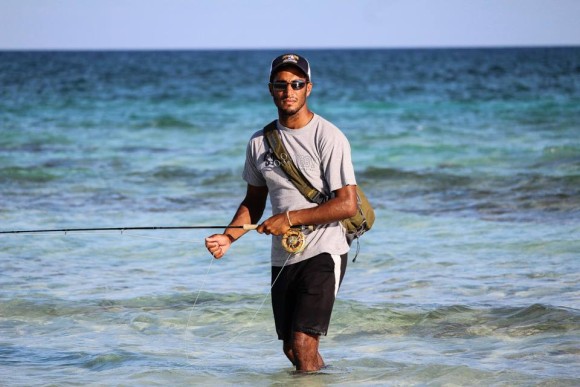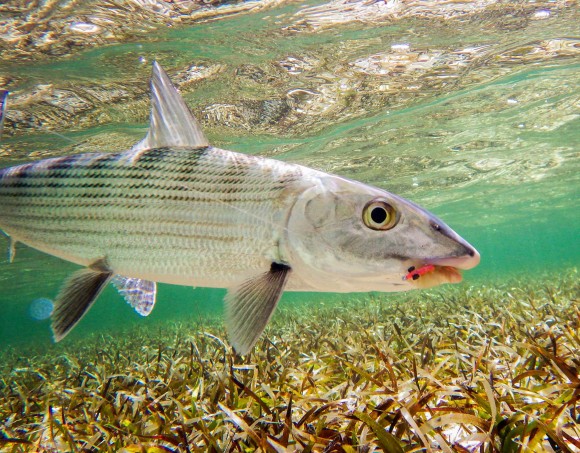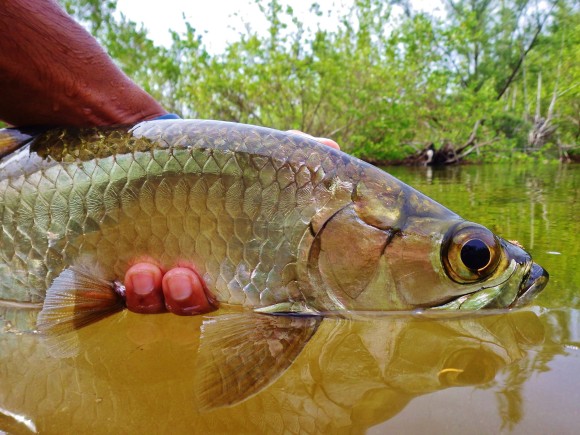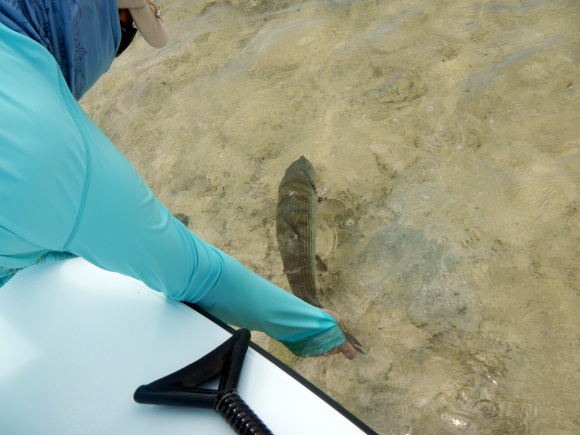As hard as it is to believe, I actually asked these questions of Justin Lewis from Bonefish & Tarpon Trust before all this Bahamas regulation stuff came up.
Justin works for BTT. He’s a Bahamian working in the Bahamas for BTT. Shows BTT’s commitment to protecting bonefish where bonefish live. I applaud that up and down and am only sorry I have but two hands to applaud with. See… BTT is awesome.

Justin Lewis in the Bahamas
You are working with BTT out in the Bahamas. Can you give me an overview of what that work entails?
Working as the Bahamas Initiative Manager for the BTT, I travel around the Bahamas visiting lodges and working with local guides which has helped us identify bonefish home ranges, juvenile habitat, bonefish spawning sites, and bonefish spawning migration pathways. The Bahamas Initiative is a collaborative, multi-year program to conserve and protect the bonefish fishery and their habits in The Bahamas.
The work I do when I travel to the different islands ranges from giving presentations to guides, anglers and schools, to tagging, to snorkeling with thousands of bonefish in pre-spawning aggregations. The scientific information we collect is then applied to habitat conservation plans in conjunction with fishing guides, lodge owners, collaborating NGO’s, and the Bahamas Government.

Nice fish from Justin.
What is one thing you wish anglers knew about conservation.
The one thing I wish anglers knew about conservation is how much they are capable and welcome of getting involved in conservation efforts. For the work we do at BTT, angler and guide participation is key to the success of many of our projects. For example, our tag-recapture study in the Bahamas involved a lot of angler and guide participation. From anglers and guides tagging bonefish and reporting recaptures we were able to figure out that bonefish have very small home ranges (<1km), and also travel long distances (>30km) for spawning purposes. By anglers participating in research like the tagging program, the information they help collect is vital to conservation efforts and planning for bonefish and their habitats. It is also a great way to give back to the resource we have such a passion for.
The BTT in collaboration with Florida Fish and Wildlife Commission has initiated a new genetics study looking at the connectivity of bonefish and tarpon populations in the Bahamas, Caribbean, and Western Atlantic. We collect fin clips from bonefish and scales from tarpon that are used for genetic analysis, and can help us determine whether different populations are related to one another. If anglers or guides who target bonefish or tarpon in those areas are interested in participating in this study, they can request a fin clip or scale sample kit by contacting us at info@bonefishtarpontrust.org.

A baby poon, Bahamas style.
What’s one unexpected thing you’ve see out there on the flats?
On a flat in Eleuthera, I saw a very large porcupine fish. I’ve seen them countless times out on the reef, but never thought I’d ever see one on the flats.
What do you think is the biggest threat to Bahamian bonefish?
We have identified habitat loss and degradation to be the greatest threat to bonefish populations in the Bahamas. Lots of areas that are prime feeding and spawning habitat for bonefish are also sought after by developers for sand mining or hotel and marina developments. Removing or altering habitat could negatively affect a local bonefish population that depends on habitats like mangroves and seagrass beds for food and cover.
How good is the Bahamian rugby team? And please explain how to play rugby. (I admit I asked this question to be funny, but Justin just went ahead and answered it anyway)
We are a good team and have a lot of talent, but we still have things we need to improve on. We had a good international season this year, beating both Bermuda and Turks & Caicos.
Rugby is a continuous game whereby two teams carry, pass, kick and ground the ball in order to score. In rugby there are 15 people playing at a time per side. The key to playing rugby is that you always have to pass the ball backwards, and to be in support of the man with ball in order to receive a pass or ruck in order to secure the ball. The purpose of the ruck or maul is so that the game can continue without any stoppage in play. The line-out and scrum are two key distinguishing factors to the game of Rugby Union. A scrum occurs when there is an accidental infringement and a line-out occurs when the ball goes out of bounds. A try is scored when a player places the ball in the opposition’s in-goal area, and is worth 5 points followed by a conversion kick which is worth 2.
On an average day of bonefishing, average conditions, what fly are you pulling out for your first cast?
Well that all depends on the area I am fishing. My go-to fly for most situations is a simple crab pattern, most of the time a merkin or bastard crab that will match the bottom I am fishing. The two keys to choosing the right crab pattern is weight and color. Match the weight of the fly to the depth of water you are fishing, and as I already mentioned match the color of the crab fly to the bottom. Most of the time crabs will take on the color of the bottom they are on. Crabs have a very high caloric value which bonefish love, so to heighten your chances of getting one to look and hopefully eat, I’d recommend a crab fly.
If you were writing the laws in the Bahamas and could enact one law to help the fishery stay healthy, what law would you enact?
If there was one law I could enact, it would be the protection of key bonefish habitat from unsustainable development. From the research BTT and our collaborators have done over the years on bonefish, we have come to the conclusion that degradation, blockage, and removal of bonefish habitat is the greatest threat to the species.
One other law I would enact is total ban of gill nets. They are a non-selective and extremely destructive type of fishing, and if they get lost and float at sea or get stuck in mangroves, they can cause even more destruction by entangling any marine organism that gets near it.
Thanks Justin!





